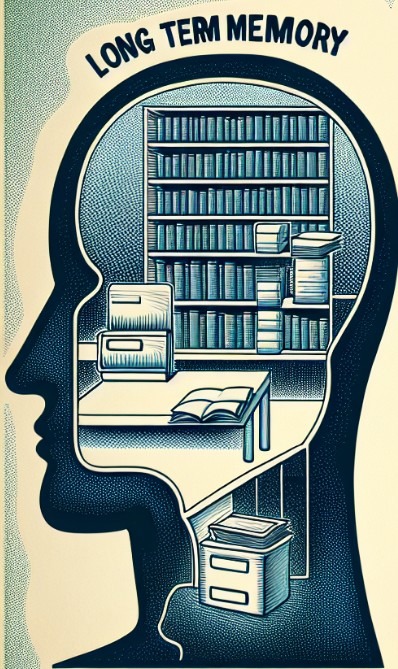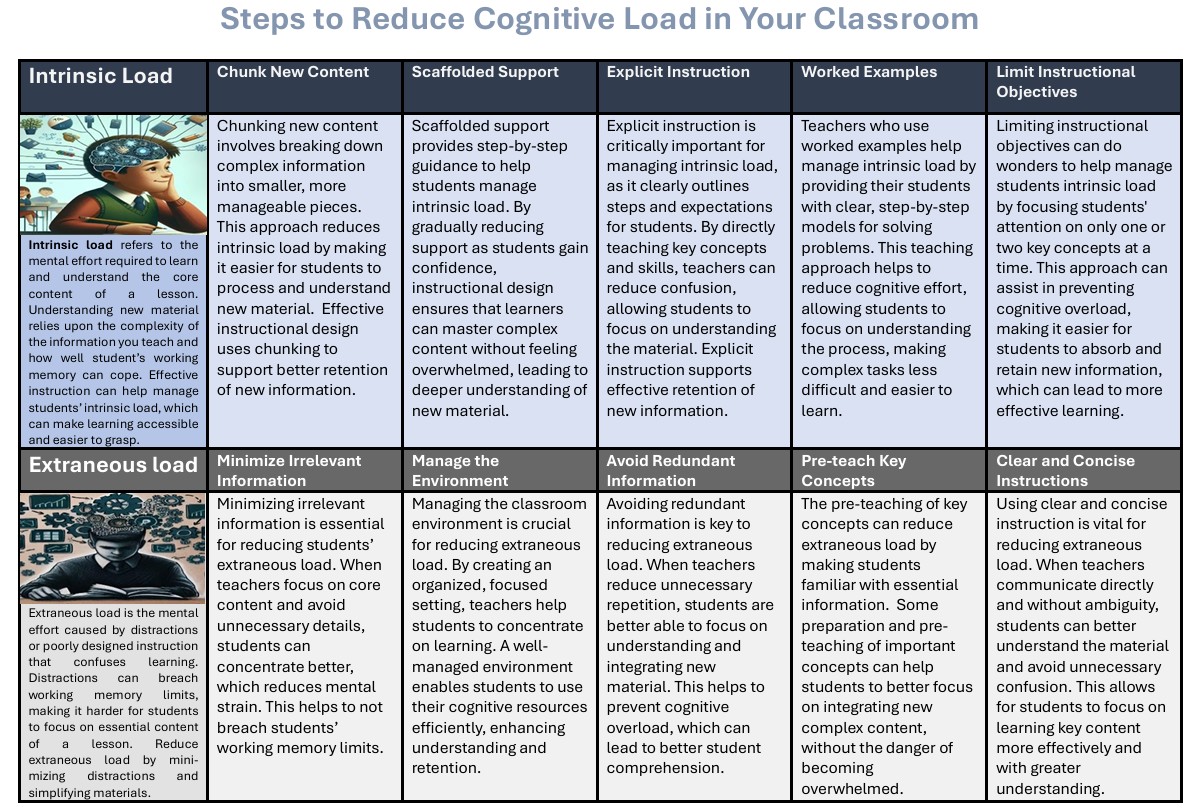Cognitive Load - Lighten Learning Demands

Cognitive load - Lighten Learning Demands.
Cognitive Load Theory, originally developed by educational psychologist John Sweller, is a powerful cognitive framework that helps us understand how our brains learn best. Much of the content on this page is based on Ollie Lovell's excellent short book, Cognitive Load Theory in Action.
At the core of cognitive load theory is the fundamental recommendation that in or order for our students to learn most efficiently, we as educators must seek to minimise extraneous load and increase intrinsic load.
Both intrinsic and extraneous load are intimately tied to our working memory, which acts as a type of bottleneck.
This important cognitive barrier determines which information from the environment is remembered and understood and which information is simply forgotten.
Working memory has a very limited capacity. Think of working memory as a tiny table which can support only so many parcels before the parcels begin to spill over the edge and fall to the ground.
Our goal as educators is to maximise our students' ability to learn new and complex information. To do this effectively a strategic understanding of intrinsic and extraneous load becomes vital.

When our tiny tables become overloaded with parcels (new information), learning will inevitably break down. For new information to be accurately processed and stored, it must learned at a rate that doesn't overwhelm the learner and also be paired with existing knowledge already nestled in long-term memory.
Teachers armed with an understanding of the limits of their students' cognitive load are well placed to create learning environments that manage this balance effectively.
This ensures that students retain and understand new material efficiently, effectively enabling the transfer of key information into long term memory.
Cognitive Load - Lighten Learning Demands: Intrinsic and Extraneous Load

When it comes to learning, not all mental effort is created equal. Intrinsic load is the natural complexity of the material itself—the essential “stuff” we want our students to focus on.
It's the challenge of grasping a new math concept, understanding a historical event, or decoding unfamiliar words. This is the productive mental struggle that builds knowledge.
In direct contrast, extraneous load is the mental clutter that distracts from learning. It is the confusing instructions, the poorly organized lesson, the buzzing classroom noise which becomes a mad swirl in an open plan classroom.
This unnecessary strain competes for our students' limited working memory space, making learning much harder than it needs to be.
Understanding these two types of cognitive load allows educators to strip away distractions and optimize their students' focus on what matters most. By managing these loads effectively, we create clearer, more engaging paths for our students to learn and succeed.
Cognitive Load - Lighten Learning Demands: Limits of Working Memory
Working memory is like the metaphor of our tiny table, a mental space, limited in size where new information is temporarily held and processed..
The problem here of course is that the table is limited in size. It is capable of holding on to only a few pieces of information at a time..
When too many packages are thrown onto the table, packages fall and become lost.
.A real world example could be a classroom teacher who provides too little explicit instruction to a classroom of early readers. In this all too common situation, students may quickly become overwhelmed and disengaged as learners if instruction is not at the required level..

Early years classroom teachers need to ensure that clear and consistent explicit instruction is maintained to ensure that their students can competently decode new words, understand the sound-letter link and recognize specific phonetic patterns.
Often, working memory breakdowns occur because students are required to make sense of too much information, presented too soon or with not enough attention to detail.
This overload can result in frustration, loss of focus, and gaps in learning.
Yet, by understanding students' cognitive load limits, teachers can plan effectively, break down lessons into manageable parts, use repetition strategically, and deliver clear step-by-step instructions.
Cognitive Load - Lighten Learning Demands: Intrinsic Load - the Heart of Good Instruction
Think of intrinsic load is the inherent complexity of new material students are expected to learn, the absolute core content a teacher wants students to focus on.
Good instructional design is vital here, as it aligns closely with intrinsic load limits. Teachers need to carefully structure lessons to match the difficulty level of the content with a solid appreciation of their students' level of understanding.
Teachers who do not have a true understanding of intrinsic load are at risk of overloading their students with instruction that is too complex, nor matched to their students level of need.
A breach of working memory limits can quickly lead to student frustration and disengagement. Students' limited working memory capacities do become overwhelmed by information that is either too difficult to learn, introduced too soon or not parsed in a way that is manageable for students.

All learning that matters requires mental effort on the part of our students will have an unavoidable level of intrinsic load. The trick is to accept that this will be the case, but place safeguards in place so that the learning that needs to be mastered does not overwhelm.
Returning to our phonics lesson example, if our teacher introduces too many new sounds or concepts at once, the inherent intrinsic load may breach working memory capacity of most the class, if not all of the class.
Certainly, it will breach the working memory limits of those more vulnerable students who may have oral receptive language difficulties or associated learning difficulties..
Such students may struggle to process any new alphabetic codes well. Large sections of new information such as vitally important letter sound links can become lost in the ether (think of out tiny table metaphor) and fail to transfer to long term memory.
Understanding intrinsic load levels often simply means classroom teachers adhering to tightly structured lessons delivered with fidelity that are consistent in design and tone and are predictable for students.
This ensures that students' knowledge is built progressively. New information is successfully paired with learned information that has already been reliably stored in long term memory..
Cognitive Load - Lighten Learning Demands: Extraneous Load - Clearing the Mental Clutter
The best way to decrease extrinsic load, or to put it another way - distractions in the environment that divert student attention - is for your students to focus in on what is at the heart of the lesson, the intrinsic load..
Part of the responsibility of classroom teachers is to identify possible extraneous loads that assail students with unnecessary mental clutter that can quickly overwhelm working memory limits..
Begin the process of reducing extraneous load by simplifying instructions.. Use clear, concise language. Break tasks into smaller, manageable steps..
Consider adding visual aids like diagrams, charts, and images to reinforce key concepts.
Identify and minimize or even eliminate possible classroom distractions. The aim is to create a calm, organized classroom environment with managed noise levels, reduced visual clutter, and clear routines..
Click on the image below to download a guide on how to reduce cognitive load in the classroom
References
Lovell, O, 2020. Cognitive Load Theory in Action, John Catt Educational Limited
Updated 09/2024

